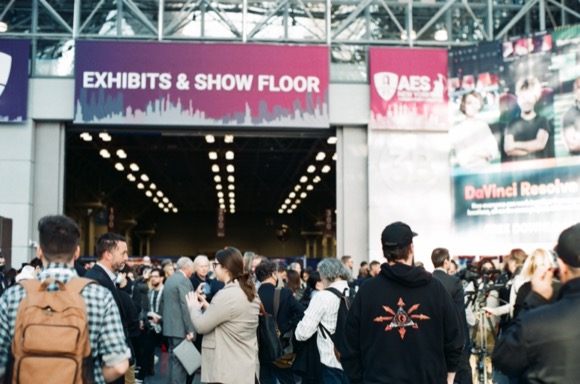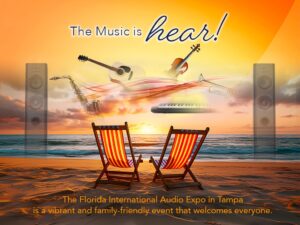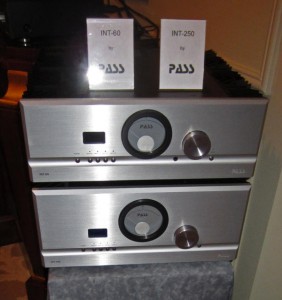
Audiofest!
Things are opening and people are going out to events finally, and one of those events is the Capital Audiofest. If you're not familiar with the event, it's a show in Rockville Maryland where individual dealers and a few manufacturers book rooms in a hotel in order to demonstrate their products. The rooms are all acoustically pretty poor so I am reluctant to make any serious judgements about sound quality there, but it's a great way to see what is out and what is new and talk with other people who are into audio. That being the case, and the show being much larger than one person can take in, this is just a bit of my general view of what I saw.

Speakers
Audio Note is one of the long-time contributors to the show, and among other things they were demonstrating their AN-E/LX speakers. Classic British sound, with a dome tweeter that isn't spitty at all and a tight recessed low end. If you've liked British speakers in the past these are worth checking out.

On the totally other end of the spectrum, AER was showing off their BD-5 which was an open-baffle full-range driver, accompanied by an external subwoofer. The bass integration was hard to figure out given that we were in a small square cement room, so even though I am no fan of open-baffle designs I would like to hear this in a better room.
Fyne Audio was showing the F1-8 which was a coaxial single-point design with a compression driver and horn. The actual design both looked and sounded like the Tannoy systems, which I have always liked. Detailed without being harsh or spitty.
Kerr Acoustic had the K320 MK3 speakers which are floorstanding 2-way systems with a a true ribbon tweeter, and with the clean top end of a true ribbon tweeter too.
Nola had their Baby Grand Reference 3 speakers, which have a sort of line array for upper midrange and treble in order to get a narrow vertical dispersion and a wide horizontal dispersion without any horns of waveguides. It was hard to tell how well it worked in the rather poor room, but it's worth listening to under better conditions.
Volti Audio was showing their Rival horn-loaded system and although I am not a horn fan, I have to say the workmanship on this system is incredible and if you like horns you should give this a listen.
I want to say that I heard a lot of speaker systems with spitty and clangy sounds which were clearly speaker deficiencies and were clearly isolatable to the speaker even with the terrible room acoustics. I really am kind of ashamed at the wide variety of unnatural sounds which seem to be considered acceptable in the high end community. Demand better. Don't put up with it! One vendor was selling a beautifully-finished speaker system with beautiful cabinetry for $40,000/pair which was nothing but painful to listen to.

Headphones!

More Great Headphones!
Headphones
Once again they had a headphone lounge where you could listen to various headphones from different vendors and compare them. This is one of the best parts of the show in part because you can audition headphones in any room no matter how bad the room acoustics are. Vendors included Audeze, Stax, and folks like the Linear Tube Audio people who were demonstrating their headphone amps.

Acoustical Treatment
As mentioned above, the quality of the rooms are real problems for auditioning anything. There's only a limited amount that you can do in a cement cube, but I am surprised so few vendors actually tried. Alma Audio was showing the Nemesis line of audio diffusion products. They make a lot of different products with different bandwidth and appearance to fit in with any room décor. I am really, really surprised that there were not more acoustical control products out there.
Amplifiers
Two companies were showing off Class D amplifiers with totally different philosophy of design and sales, and I found the contrast interesting.
AMPED was showing their AMP 2400, a conventional black-box stereo amplifier, 400W with a class D output stage for high efficiency and low weight. Solid and workmanlike, and they talked about the advantages of the class D design.
AGD Productions took the opposite approach with their GANTube monoblock, which has a class D output stage using gallium nitride semiconductors, mounted in a cool glass tube. The sales material seems to go out of their way not to mention that it's a class D design and seems to try to make analogies to tube amps. The GAN semiconductors are very fast and are becoming quite popular with class D designs because faster and more accurate switching leads to lower distortion and cleaner sound. This looks like a beautifully designed class D amplifier but they don't want to tell you about any of the advantages that this brings.
I'm not a huge class D fan but as technology improves and class D systems sound better and better, I could see myself becoming one. Especially after spending a weekend loading a heavy rack of Urei monitoring amps in and out of a job.

The guys from Volti were showing their classic loudspeakers off with the Atma-Sphere Novachron amplifiers. These amps are unfortunately out of production but they are some of the best OTL tube amplifiers ever made. Volti was using the high current 7241 regulator tube in place of the higher impedance 6C33C tubes as well, which is something I had never seen.
Elekit was showing their line of reasonably-priced and well-designed tube amplifiers.
And on the conventional solid-state front, Bricasti was showing their M25 stereo power amplifier. These things offer 150W into 8 ohms and 600W into 2 ohms, and that linear change implies that their actual output impedance is extremely low and they are able to provide extreme damping. Not many amps can say this.

Inside the Convergent
Preamplifiers
There weren't too many conventional analogue preamplifiers at the show but one that stood out was the Convergent Analog Technologies SL1. This was a traditional tube preamp, built very well with care and attention to detail. Film capacitors throughout the audio path, highly filtered and regulated power supplies, and beautiful board layout.
Phono Stuff

Haniwa Audio was showing their ultra-low-impedance HCTR Mk II. phono cartridge. With an effective output impedance of 0.4 ohm, it requires lower resistance head wiring and a special transformer box that they make. It sounded good and seemed quiet. Low source impedance means a lighter voice coil which is a route toward better tracking and lower distortion.
Lots of turntable vendors were there and I couldn't even get into the VPI demos because they were so packed with customers! I was delighted to see how popular they were but I would like to have heard more about what they were doing.
Massif Audio Design was showing modern record weights, and as a user of the long-discontinued Keith Monks weights, I have to say that the record weight is one of the best things you can do for record playback. They want a bit more than I would probably be willing to pay, but they're beautifully made and nobody could say they weren't art.
Reliable Corporation had their Uberlight Flex, a convenient gooseneck lamp that can be mounted on your turntable plinth to provide good task lighting, especially in a darker room. Why has nobody made this before?
Ginko Audio was selling some small wooden springs called the ARCH which may be of good use in turntable isolation. They have long made a good line of isolation products and this is their latest design.
Two companies were selling ultrasonic record cleaning systems with rather different approaches. The Kirmuss Ultrasonic Record Restoration System employs a polar surfactant applied to the record surface before cleaning while the Isonic record cleaner uses the more common method of a surfactant within the solution. I'm not qualified to say which approach is better but both of these systems are worth looking into.
Wally Analog was showing a variety of turntable setup tools, for setting up all aspects of cartridge and turntable geometry. Ingenious gadgets for properly setting anti-skate as well. Anybody who uses a turntable should see what they have to offer.

The Association for Recorded Sound Collections had a booth, manned by a number of well-known people in the field including Matt Barton from the Library of Congress and David Giovannoni from First Sounds. These are folks who know how to take care of records and who can tell you how to take care of them too, and it is good to see them there.

Michael Fremer gave an interesting talk about common myths about vinyl records. He brought along Ulrike Schwartz and Jim Anderson who made for an interesting panel of people who clearly knew the technology.
Digital Stuff
Audioshield Distribution was showing off the Meitner MA-3, which is a DAC but also a streaming box. It takes inputs in a variety of formats from USB, S/PDIF, and ethernet, as PCM or DSD data, and produces clean audio out. There's nothing on the analogue end other than a volume control. I have used the Meitner professional gear and I am delighted to see them bringing the same approach to home audio equipment.
Margules had their BTV4 Magenta Bluetooth Receiver. This is a box that links to your bluetooth audio source and can accept connections from a variety of codecs and produce analogue outputs for your stereo system. Some folks love the idea of the convenience, some folks will complain the audio quality still isn't up to par, others might want an S-PDIF output. But for shared systems where a lot of people are going to be using them, the ability to accept inputs from random bluetooth devices might be a plus.
A company called Theoretica Applied Physics was demonstrating a system called the BACCH-SP which they called a "stereo purifier." This was a processor that sits in your playback system which they claim improves stereo imaging by offering adaptive crosstalk cancellation specifically designed for your ears using measurements derived from in-ear microphones. I am, of course, very skeptical of any stereo-image-improving device because it's so hard to tell what differences are actually improvements. And I am even more skeptical when the actual algorithm used is not documented. But if you have a chance to listen to this system, preferably in a room that isn't so boomy as the one they were forced to demonstrate it in, you might want to decide for yourself.

Furniture
A company called MOSART was showing a variety of exotic and angular cabinets for record storage, equipment storage, or what have you. Beautiful custom workmanship although not necessarily audio-related.

Misc
The DC Hi-Fi group was there and although they didn't have as cool a display as they have in some previous years with a lot of people's projects set up, they still had a good demo in the library. They were also advertising their annual audio rummage sale and swap meet, which looked interesting.
Overall it was a good show, and I enjoyed myself, and I was very happy to see a lot of old friends and faces there. If I missed out on something critical and important here, or you disagree with some of my opinions, feel free to comment. Hope to see you there at next year's show!








































